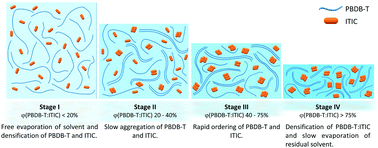Evolution of molecular aggregation in bar-coated non-fullerene organic solar cells†
Abstract
An in situ measurement technique combining spectroscopic ellipsometry and a bar coating method is introduced to monitor the film drying process of a PBDB-T:ITIC non-fullerene photovoltaic blend to illustrate the nanoscale morphology development during solution casting. Four distinct stages can be defined in the evolution of the extinction coefficient (k) according to the aggregation behavior of the polymer donor and the non-fullerene acceptor (NFA). Stage I (total volume fraction of the blend below 20%) exhibits rapid and free evaporation of the solvent while the polymer and NFA molecules move closer to each other without any self-organization. Stage II (total volume fraction between 20 and 40%) reveals the onset of slow aggregation of PBDB-T and ITIC. Stage III (total volume fraction between 40 and 75%) appears to be the rapid ordering of PBDB-T and ITIC, and Stage IV (total volume fraction higher than 75%) shows further densification of the PBDB-T:ITIC film during the slow evaporation of the residual solvent. The bar-coated PBDB-T:ITIC inverted device shows superior efficiency of over 10%, and comparable stability with the spin-coated counterpart. These findings provide a fundamental understanding of the molecular aggregation during the solution casting of non-fullerene organic solar cells.



 Please wait while we load your content...
Please wait while we load your content...